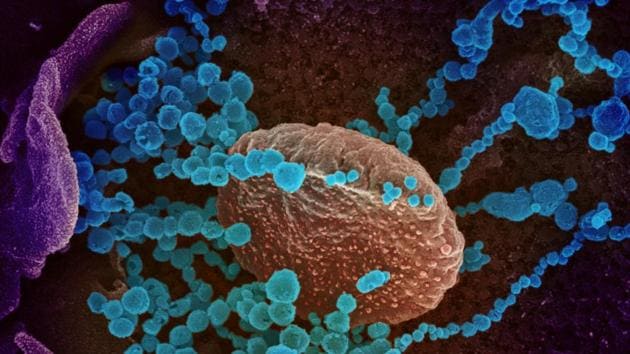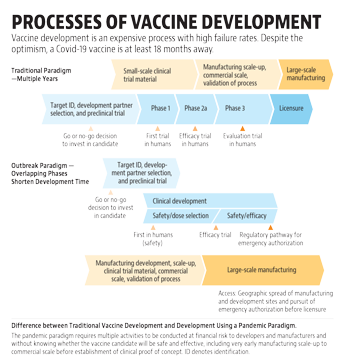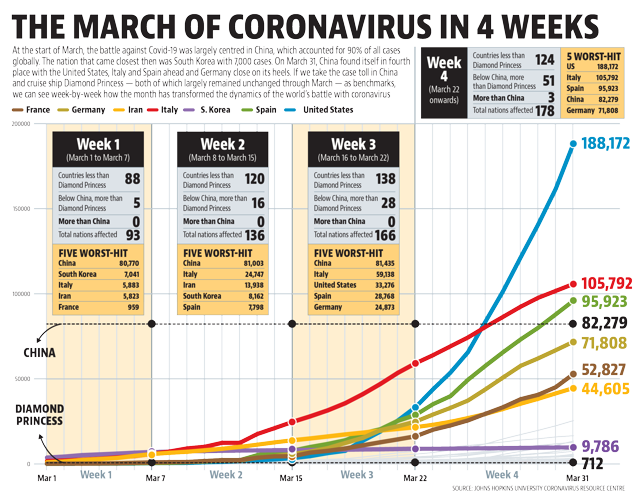Genetic sequencing takes lead in Covid-19 vaccine development
RNA and DNA are fragments of genetic material . The genome of the Sars-CoV-2, the virus that causes Covid-19, was sequenced and shared by China in early January.
In the race to develop a vaccine against the coronavirus disease (Covid-19), scientists around the world are simultaneously using multiple vaccine-development platforms, with DNA- and RNA-based platforms taking the lead because of their potential for speed.

RNA and DNA are fragments of genetic material . The genome of the Sars-CoV-2, the virus that causes Covid-19, was sequenced and shared by China in early January. Since then, several countries, including India, have sequenced the virus. These genetic sequences are used to grow the live virus and study its behaviour, including how it enters human cells and causes disease -- information critical in developing drugs and vaccines to fight it.
Work on the Covid-19 vaccine began soon after the first genetic sequence was available, and Moderna’s mRNA-based Sars-CoV-2 candidate entered a phase-1 trial (to test safety and dosage in healthy volunteers) on March 16. A non-replicating vector-based vaccine has also received regulatory clearance to start phase 1 studies in China, while approvals of for phase 1 trials of nucleic-acid vaccines are expected in April.
Click here for the complete coverage of the Covid-19 pandemic

Also Read: ‘Biggest challenge is fighting stigma’: Dr. Harsh Vardhan
“The speed with which we have [produced these candidates] builds very much on the investment in understanding how to develop vaccines for other coronaviruses,” says Richard Hatchett, CEO of the Coalition for Epidemic Preparedness Innovations (Cepi), a non-profit supporting development of vaccines against five epidemic pathogens on the World Health Organization (WHO) priority list, in a statement.
Despite the optimism, a Covid-19 vaccine is at least 18 months away. “There are candidate vaccines that are emerging all over the world. I’ve watched vaccine development on other atypical viruses, and I don’t want anybody to believe that we will have a vaccine within a month or two,” said Dr David Nabarro, one of the six World Health Organisation special envoys on Covid-19.

“Any vaccine development requires a lot of testing for to establish it’s efficacious and safe, we need to make sure countries licence the vaccine through proper procedure. They then need to get a massive build up in manufacturing capacity and have a system to ensure that those who need the vaccine the most get it first. So we really have to recognise it’s an 18-month delay; we should not anticipate (it) quicker,” said Dr Nabarro.
Vaccine development is an expensive process with high failure rates, with developers following a linear sequence of steps that include massive data analysis and manufacturing-process checks. To develop a vaccine quickly, carries higher financial risk as it requires a fast start and many steps executed in parallel before confirming a successful outcome, according to a new paper in New England Journal of Medicine (NEJM). For example, for platforms that have been tested in humans, phase 1 clinical trials may be able to proceed in parallel with animal testing.
“The use of reverse genetics and next-generation sequencing is used to shorten the time taken for development, compared to conventional vaccines. In the case of coronaviruses, the virus’s spike protein is a promising immunogen for protection and optimising antigen design to optimise immune response,” said Dr N K Ganguly, former director general, Indian Council of Medical Research.
According to the study, preclinical experience with vaccine candidates for other coronaviruses, such as the ones causing severe acute respiratory syndrome (Sars) and middle-east respiratory syndrome (Mers), have raised concerns about exacerbating lung disease, either directly or as a result of antibody-dependent enhancement.
“Since the adverse effects could be because of type-2 helper T-cell (Th2) response, vigorous animal testing and clinical trials to establish safety, dosage and adverse-effects in humans cannot be neglected. Given that Covid-19 will infect millions, there can be no compromise in data quality and regulatory reviews,” said Dr Ganguly. Th1 cells generate immune responses against intracellular parasites, such as bacteria and viruses, while Th2 cells work against helminths (parasitic worms), infections from which are very common in Asia and Africa.
Also Read: Kerala to Punjab, places that became epicentre of coronavirus infection
Lessons from vaccine development against H1N1 influenza, Ebola, and Zika, are guiding scientists. The H1N1 influenza vaccine was developed fairly quickly because influenza-vaccine technology is well developed and vaccines made using egg- and cell-based platforms could be licenced rapidly under the rules for strain changes in influenza viruses. The vaccine is now part of the commercially available seasonal influenza vaccines.
Vaccine and biotech companies are now investing in development-and-manufacturing platforms that can be adapted for new pathogens. The US National Institute of Allergy and Infectious Diseases is supporting early development and test of platforms against prototype viruses from different viral families.
Moving beyond phase 2 trials for monitoring efficacy and side-effects would also need scaling up manufacturing to commercial levels before substantial safety and immunogenicity data are available, which means if the vaccine fails, the investment in manufacturing will be wasted. “It’s therefore critical that vaccines also be developed using tried-and-true methods, even if they may take longer to enter clinical trials or to result in large numbers of doses,” said the NEJM article.
Cepi also supports development of platform technologies to prepare for Disease X, the yet unnamed next big emerging epidemic disease, such as Covid-19. “An ideal platform would support development from viral sequencing to clinical trials in less than 16 weeks, demonstrate elicitation of consistent immune responses across pathogens, and be suitable for large-scale manufacturing using a pathogen-agnostic platform,” according to NEJM.
Get Current Updates on India News, Lok Sabha Election 2024 live, Infosys Q4 Results Live, Elections 2024, Election 2024 Date along with Latest News and Top Headlines from India and around the world.




